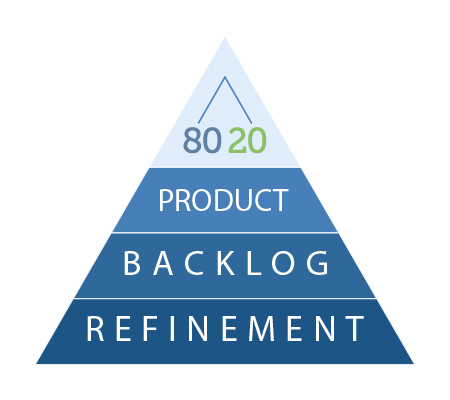There’s a popular myth that backlog refinement is just administrative work around a backlog—managing JIRA tickets and arguing about tasks and estimates.
Humanizing Work’s Co-Founder, Peter Green, recently had a conversation with his brother who plays a PO role at a large medical company. When backlog refinement came up during the course of their conversation, he groaned a bit and shared that, for his team, backlog refinement is a weekly, full-team debate about sizing, tasking, and arguing about priority and dependencies. For him, backlog refinement is red tape, busy work, and bureaucracy, and no one looks forward to it.
 For most product owners/managers we interact with, backlogs are really long lists of things that are too detailed for how far out they are in the future, but not detailed enough that somebody could just go work on them. It’s simultaneously too much detail and too little detail, and it’s usually not very strategic. It’s just the grab bag of everything everybody has thought of stuffed into a tool where it’s hard to manage.
For most product owners/managers we interact with, backlogs are really long lists of things that are too detailed for how far out they are in the future, but not detailed enough that somebody could just go work on them. It’s simultaneously too much detail and too little detail, and it’s usually not very strategic. It’s just the grab bag of everything everybody has thought of stuffed into a tool where it’s hard to manage.
And a lot of product owners we talk with say they don’t feel like they have enough time to really collaborate with their team on the short term work. Nor do they have enough time to get strategic about what’s going on in the long term. They’re stuck in this messy middle where they’re not experiencing anything really good, and they don’t have time to go do some of the other important things that are not backlog refinement, like customer research, product assumption testing, and vision.
Humanizing Work’s Founder, Richard Lawrence, recalls working with a team that went from struggling to delivering reliably in weekly sprints in about six weeks. It was an impressive turn-around…until the team realized nobody wanted the thing they were building.
That was the point where Richard first realized that product ownership/management is a prerequisite to everything else. It doesn’t matter how good your developers are if they’re building the wrong thing—or don’t have something of value to build.
This means backlog refinement isn’t just admin work around the backlog. *Good* backlog refinement is, in fact, one of the best levers you have for a return on your biggest investment, which is the staffing cost of your team.
Bad Backlogs Are Staggeringly Expensive
We often don’t realize how big the numbers are when there’s a whole team of professionals working on something. Consider the costs of salary, benefits, tools, office space—all the different things that you’re paying for. The quick back of the napkin version of this we use when we can’t actually calculate it is a fully loaded cost of about $1,000 per person per day for a software developer-type professional in the United States. This means a typical Scrum team of seven people is $7,000 per day or $70,000 for a two-week sprint.
And those numbers only increase when the team is based in a region with a higher cost of living, like Seattle or the Bay Area. If you have a bigger team, your costs are even bigger. So when the team is building the wrong thing, or don’t have something of value to build, it’s not just lost time. There’s a significant cost. (Never mind the opportunity cost, since what you’re building should be more valuable than just what it costs to build.)
The number one thing that determines the return on your investment is having the right detail at the right time in your backlog and being aligned around what it is and what it means. Good value represented in your backlog makes it most likely you’re going to get something valuable out the other end. If your backlog is not in good shape, you can have $100,000 worth of investment going in the wrong direction, floundering, or reworking things the team misunderstood and did wrong.
The #1 Skill That Creates Good Backlogs
Good backlog refinement does three things:
- It reliably gets the right things at the right places in the backlog, especially the most important things at the top.
- It always has just enough detail at the right time. So neither too much too early, which causes churn, nor too little too late, which causes scrambling and rework when you try to plan.
- It creates alignment among everybody involved so everyone knows how to contribute and build the right thing and go in the same direction.
Get this right, and that expensive team knows where to focus and produces positive results sprint after sprint.
One skill makes this outcome more likely: breaking down big ideas into smaller slices that provide meaningful value, learning, and risk mitigation as you go. But product professionals everywhere struggle with this.
Over 15 years ago, Richard discovered a set of patterns for splitting user stories that worked for his team. He thought it might be helpful to some other teams, too, so he wrote the article “Patterns for Splitting User Stories.” A few years later, he published a “How to Split a User Story” flowchart as a cheat sheet for the patterns.
The response was overwhelming. Today, over 2 million story splitting posters have been downloaded, and it has been translated into 13 languages.
Fortunately, story splitting is a skill where you can go from zero to fluent after a few hours of deliberate practice. There’s almost no other skill we use in work that can produce such results so fast.
A New Course from Humanizing Work
 We’ve spent the better part of the year designing and producing a new course, and we’re excited to announce its release today. Introducing 80/20 Product Backlog Refinement, a self-paced course that shares a set of proven techniques for finding the high-value, high-learning slices to maximize impact and minimize risk.
We’ve spent the better part of the year designing and producing a new course, and we’re excited to announce its release today. Introducing 80/20 Product Backlog Refinement, a self-paced course that shares a set of proven techniques for finding the high-value, high-learning slices to maximize impact and minimize risk.
Here are some of our favorite lessons that are particularly high leverage for most of our clients.
Feature Mining. Out of all the different things that we teach, feature mining reliably gets you from, “I’ve got this big, complex idea and I don’t know how to start,” to, “Okay, here’s the first slice we’re going to do.” Being able to find that first meaningful slice gets you momentum that makes everything else flow after that.
Prioritization. Almost every product owner we talk with complains about pain around prioritizing, and we’ve come to believe the prioritization problem isn’t really a ranking problem. People try to solve it with spreadsheets and calculations, but that’s not where you’ll find the solution. Slicing skills sidestep most of the pain that people experience around prioritization, and this lesson can unlock that for somebody getting started with the course right away.
The PO Board. This lesson shares a way of structuring your backlog to turn backlog refinement into a sustainable thing instead of a weekly meeting that nobody wants to go to.
While clients have been able to get this updated material in our live workshops, this new course allows us to make the content available to a wider audience for a fraction of the cost of an in-person workshop or coaching session.
In terms of the return on investment on this, if a product owner spends a couple hundred dollars on this course and spends half a day to a day practicing with the things that they’re learning, that investment pays for itself in one sprint.
And if that helps a team go from working on the wrong things to working on the right thing together, you just got 200% or more return on investment on that one thing.
Here’s what people who have completed the course have had to say:
There is so much here I can bring back to my teams and POs to make our jobs easier. I need all my people to take this class! (Cristy, ScrumMaster)
This course has practical content to apply right away. (Yu Ju, Agile Coach)
We think everyone benefits from getting better at Product Backlog Refinement. Even people not in PO roles, even people outside of software, because all of us have big goals and would benefit from slicing them up into small slices that build momentum and value quickly.
80/20 Product Backlog Refinement is available now for just $197. Sign up today and elevate your product management skills and transform your approach to backlog refinement.
Last updated